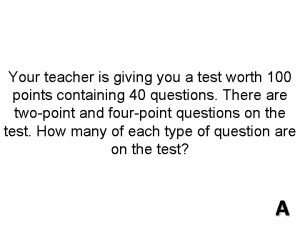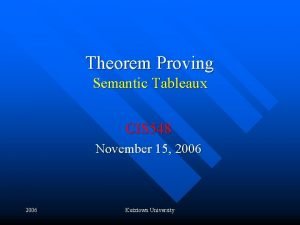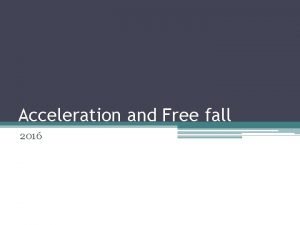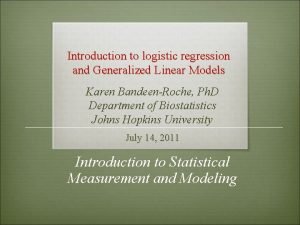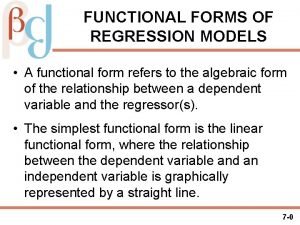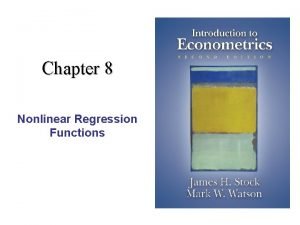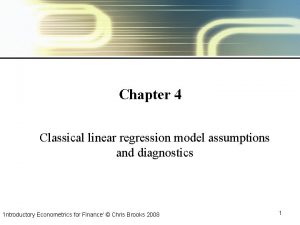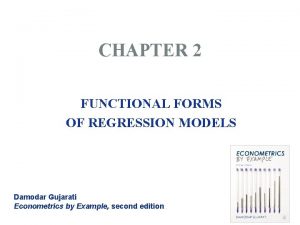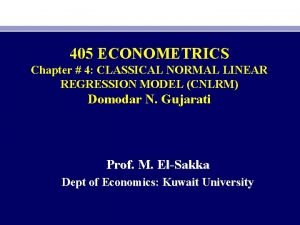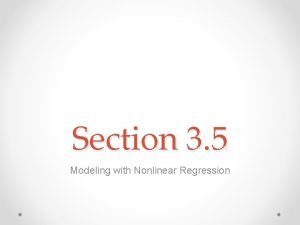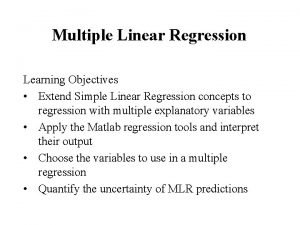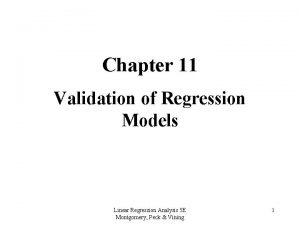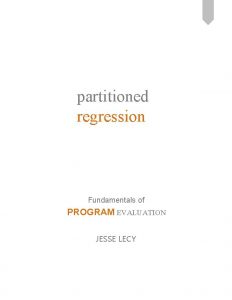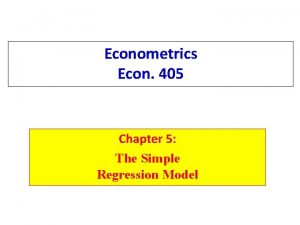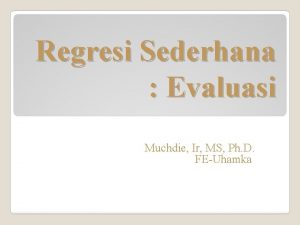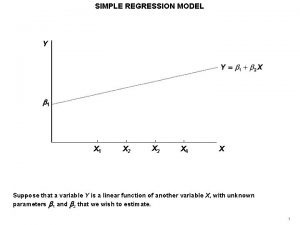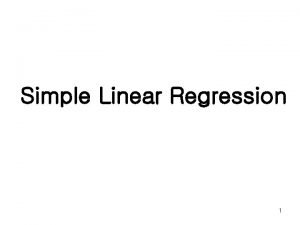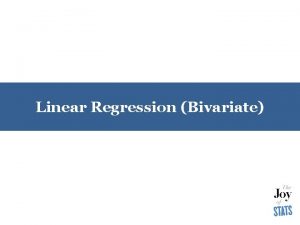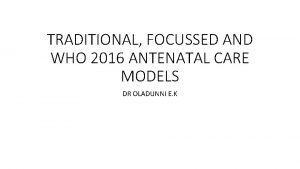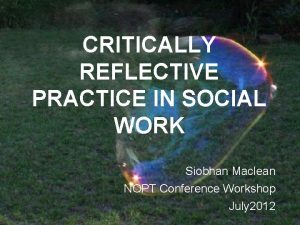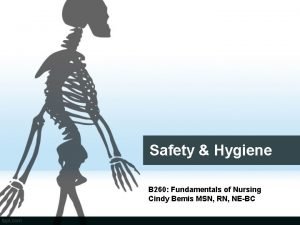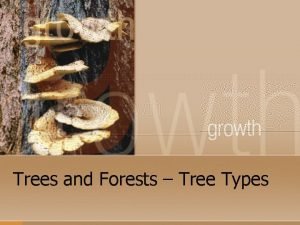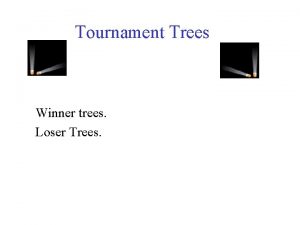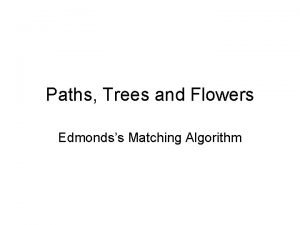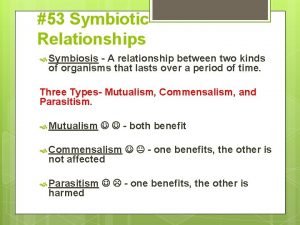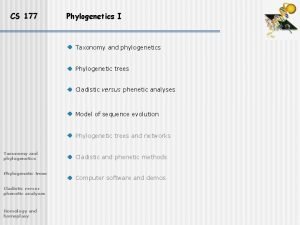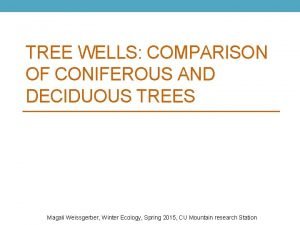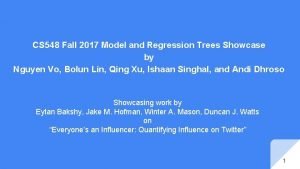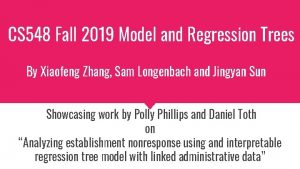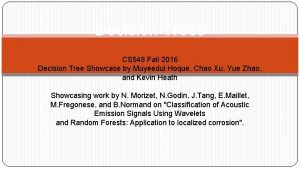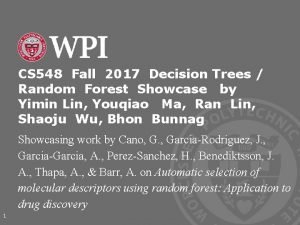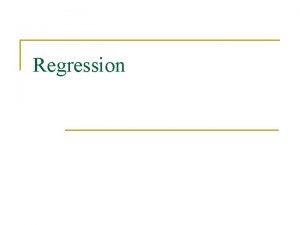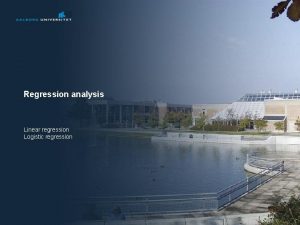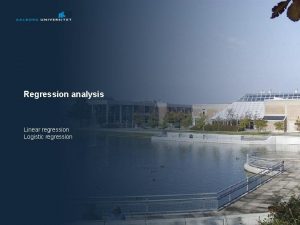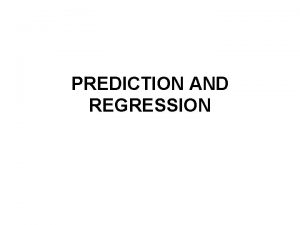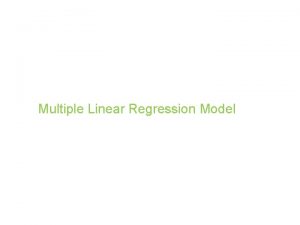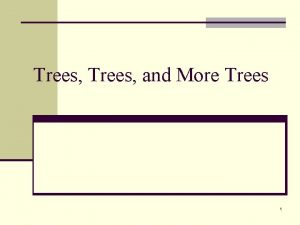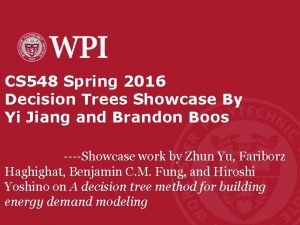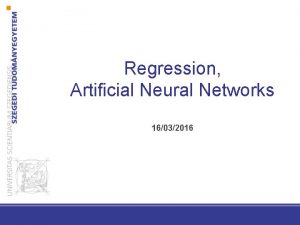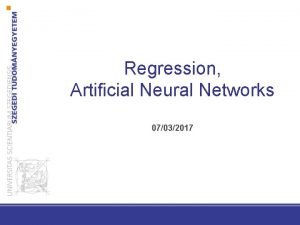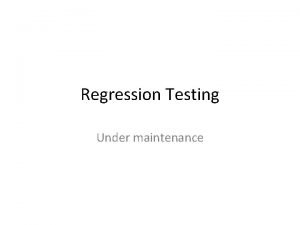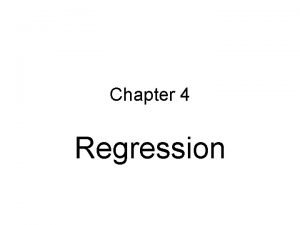CS 548 Fall 2016 Model and Regression Trees













































- Slides: 45

CS 548 Fall 2016 Model and Regression Trees Showcase by Tom Hartvigsen, Mu Niu, Qingyun Ren, and Allison Rozet Showcasing work by Jinxian Weng, Yang Zheng, Xiaobo Qu, and Xuedong Yan on “Development of a maximum likelihood regression tree-based model for predicting subway incident delay, ” Transportation Research Part C: Emerging Technologies, vol. 57, pp. 30 -41, Aug. 2015.

References • H. Akaike, “A New Look at the Statistical Model Identification, ” IEEE Transactions on Automatic Control, vol. 19, issue 6, pp. 716 -723, Dec. 1974. • Y. Chung, “Development of an Accident Duration Prediction Model on the Korean Freeway Systems, ”Accident Analysis & Prevention, vol. 42, issue 1, pp. 282 -289, Jan. 2010. • G. James, D. Witten, T. Hastie, R. Tibshirani, An Introduction to Statistical Learning: With Applications in R, New York: Springer-Verlag New York, 2013. • X. Su, M. Wang, J. Fan, “Maximum Likelihood Regression Trees, ” Journal of Computational and Graphical Statistics, vol. 13, no. 3, pp. 586 -598, Sep. 2004. • J. Weng, Y. Zhang, X. Qu, X. Yan, “Development of a Maximum Likelihood Regression Tree-Based Model for Predicting Subway Incident Delay, ” Transportation Research Part C: Emerging Technologies, vol. 57, pp. 30 -41, Aug. 2015. • Hong Kong Subway Delay Penalty News (2014, May 15). [Online]. Available: http: //news. sina. com. cn/c/2014 -0515/090830140431. shtml • Hong Kong Subway Delay Frequency and Penalty Article (2015, Sep. 8). [Online]. Available: http: //www. vccoo. com/v/f 54362

Outline • Background & Case Study • Methodology • Model Evaluation https: //cleantechnica. com/2014/11/17/hong-kongs-metro-success/

Background & Case Study

Preliminaries • Subway incident - the breakdown of a subway service caused by system component failures • Delay - the difference between the scheduled and actual subway train departure times • Hong Kong’s Mass Transit Railway (MTR) is fined up to $1. 9 million USD every time there is a delay that lasts 31 minutes or more. • In 2012 and 2013, the MTR was fined $5. 2 million USD. • 2012 → $1. 7 million USD; 2013 → $3. 5 million USD • In 2015, the MTR had a 5 -minute delay for every 1. 7 million km run. • Fined $770, 000 USD for the first half of the year.

Contributions to MTR • • To build a model that accounts for the heterogeneity effect and avoids the overfitting problem. To help subway staff to quickly implement the most effective strategies for reducing subway incident delays. https: //cleantechnica. com/2014/11/17/hong-kongs-metro-success/

Data resource • Hong Kong subway incident data between 2005 and 2009 ▪ Legislative Council of Hong Kong ▪ Google research

Data • 11 attributes ▪ ▪ ▪ • 2 attributes represent time 8 major causes of subway incidents 1 target attribute represents delay time 1332 subway incident records ▪ 80% for training (1066 records). ▪ 20% for tree validation (266 records)

Frequency distribution • Statistical numbers ▪ ▪ ▪ • Range: 8 min to 418 min Standard deviation: 18. 2 min Mean: 14. 6 min Showed the distribution of subway incident records

Result • Initial split is at door failure • 10 terminal nodes in total • Check increment of loglikelihood ▪ If positive, split further ▪ If negative, set as terminal node • Assigned unique AFT models to each terminal nodes

Methodology

Accelerated Failure Time (AFT) Model Chung, 2010 Variable Coefficient Percent Change Day of the week -0. 2126 e-0. 2126 ≈ 0. 81→ 19% decrease

Maximum Likelihood Regression Tree-Based Model • Subway Incident Delay is a Continuous Target Variable

Maximum Likelihood Tree Structure • Two steps: Tree Growing and Tree Pruning

Maximum Likelihood Tree Structure • Two steps: Tree Growing and Tree Pruning

Maximum Likelihood Tree Structure • Two steps: Tree Growing and Tree Pruning • Tree Growing

Maximum Likelihood Tree Structure • Two steps: Tree Growing and Tree Pruning • Tree Growing • Determining the best variable and split point

Maximum Likelihood Tree Structure • Two steps: Tree Growing and Tree Pruning • Tree Growing • Determining the best variable and split point • Step 1. Determine parameters of the AFT models using maximum likelihood estimation techniques

Maximum Likelihood Tree Structure • Two steps: Tree Growing and Tree Pruning • Tree Growing • Determining the best variable and split point • Step 1. Determine parameters of the AFT models using maximum likelihood estimation techniques

Maximum Likelihood Tree Structure • Two steps: Tree Growing and Tree Pruning • Tree Growing • Determining the best variable to and split point • • Step 1. Determine parameters of the AFT models using maximum likelihood estimation techniques Step 2. Compute maximum log-likelihood increment on the parent node by a split s

Maximum Likelihood Tree Structure • Two steps: Tree Growing and Tree Pruning • Tree Growing • Determining the best variable and split point • • Step 1. Determine parameters of the AFT models using maximum likelihood estimation techniques Step 2. Compute maximum log-likelihood increment on the parent node on var. x • Choose s based on log-likelihood gain

Maximum Likelihood Tree Structure • Two steps: Tree Growing and Tree Pruning • Tree Growing • Determining the best variable and split point • • Step 1. Determine parameters of the AFT models using maximum likelihood estimation techniques Step 2. Compute maximum log-likelihood increment on the parent node on var. x • • Choose s based on log-likelihood gain Split can only be used if this increment is greater than zero (purity must improve)

Maximum Likelihood Tree Structure • Two steps: Tree Growing and Tree Pruning • Tree Growing • Determining the best variable and split point • • • Step 1. Determine parameters of the AFT models using maximum likelihood estimation techniques Step 2. Compute maximum log-likelihood increment on the parent node on var. x Step 3. Best variable is chosen based on log-likelihood gain

Maximum Likelihood Tree Structure • Two steps: Tree Growing and Tree Pruning • Tree Growing • Determining the best variable and split point • • Step 1. Determine parameters of the AFT models using maximum likelihood estimation techniques Step 2. Compute maximum log-likelihood increment on the parent node on var. x Step 3. Best variable is chosen based on log-likelihood gain Step 4. If gain is less than or equal to zero, parent node becomes a terminal node • Otherwise, we choose variable x* and split s* to split parent node k

Maximum Likelihood Tree Structure • Two steps: Tree Growing and Tree Pruning • Tree Growing • Determining the best variable and split point • • Step 1. Determine parameters of the AFT models using maximum likelihood estimation techniques Step 2. Compute maximum log-likelihood increment on the parent node on var. x Step 3. Best variable is chosen based on log-likelihood gain Step 4. If gain is less than or equal to zero, parent node becomes a terminal node • • Otherwise, we choose variable x* and split s* to split parent node k Step 5. Stop splitting based on a criterion • • No nodes can be split further Tree depth has reached a preset maximum depth threshold

Maximum Likelihood Tree Structure • Two steps: Tree Growing and Tree Pruning • Tree Growing • Determining the best variable and split point • • Step 1. Determine parameters of the AFT models using maximum likelihood estimation techniques Step 2. Compute maximum log-likelihood increment on the parent node on var. x Step 3. Best variable is chosen based on log-likelihood gain Step 4. If gain is less than or equal to zero, parent node becomes a terminal node • • Otherwise, we choose variable x* and split s* to split parent node k Step 5. Stop splitting based on a criterion • • • No nodes can be split further Tree depth has reached a preset maximum depth threshold Otherwise, return to step 1

Maximum Likelihood Tree Structure • Two steps: Tree Growing and Tree Pruning • Tree Growing • Tree Pruning

Maximum Likelihood Tree Structure • Two steps: Tree Growing and Tree Pruning • Tree Growing • Tree Pruning • Large trees may raise generalization error: Overfitting

Maximum Likelihood Tree Structure • Two steps: Tree Growing and Tree Pruning • Tree Growing • Tree Pruning • Large trees may raise generalization error: Overfitting • Cost-complexity pruning approach

Maximum Likelihood Tree Structure • Two steps: Tree Growing and Tree Pruning • Tree Growing • Tree Pruning • Large trees may raise generalization error: Overfitting • Cost-complexity pruning approach • Minimize Akaike Information Criterion (AIC)

Maximum Likelihood Tree Structure • Two steps: Tree Growing and Tree Pruning • Tree Growing • Tree Pruning • Large trees may raise generalization error: Overfitting • Cost-complexity pruning approach • Bottom-up, examine each node and subtree

Maximum Likelihood Tree Structure • Two steps: Tree Growing and Tree Pruning • Tree Growing • Tree Pruning • Large trees may raise generalization error: Overfitting • Cost-complexity pruning approach • Bottom-up, examine each node and subtree • Step 1. Calculate AIC for the tree after removing node h

Maximum Likelihood Tree Structure • Two steps: Tree Growing and Tree Pruning • Tree Growing • Tree Pruning • Large trees may raise generalization error • Cost-complexity pruning approach • Bottom-up, examine each node and subtree • • Step 1. Calculate AIC for the tree after removing node h Step 2. Search for the best parent node h* to remove • Based on the smallest AIC(Tj-Th)

Maximum Likelihood Tree Structure • Two steps: Tree Growing and Tree Pruning • Tree Growing • Tree Pruning • Large trees may raise generalization error • Cost-complexity pruning approach • Bottom-up, examine each node and subtree • • • Step 1. Calculate AIC for the tree after removing node h Step 2. Search for the best parent node h* to remove Step 3. Let the optimal tree be T* • • If AIC(T*) ≥ AIC(Tj), return T* Otherwise, set the initial tree Tj as T* and j = j + 1

Model Evaluation

Tree Analysis • The optimal tree has 10 terminal nodes • More terminal nodes won’t lower the AIC value of the validation set

Result

Impact analysis • Assigned unique AFT model to each terminal node • Repeatedly remove variables with significant level larger than 0. 1

● Terminal 1: vehicle failure could increase delay by 93. 9% (=e^0. 6623 -1)

● Compare Node 2 & 3: delays caused by power failure is 64. 8%(=(23. 414. 2)/14. 2) longer than not caused by power failure. (Baysari et al. , 2009)

● Terminal 2 : subway incident delay will increase 527%(=e^1. 835 -1) when the delay involving power failure also involve operation problems.

Merits • Subway staff could easily determine the distribution of subway delays • Assigns an AFT model instead of the sample mean value to each terminal node • Avoids the overfitting problem • Overcomes the shortcomings of traditional AFT models *. *AIC =257 in validation set, which is the smallest. *MAPE=27. 2% and RMSE=4. 9% both are smallest.

Limitations • Requires a large data sample ▪ ▪ Samples need to be divided into training set and validation set Each terminal node needs adequate data so that AFT model for each terminal node can be developed • Computational cost is high • We’ll have biased/incorrect results if insufficient data are used

Questions?

Thank you
 Gabby and sydney bought some pens and pencils
Gabby and sydney bought some pens and pencils Cis548
Cis548 Round 716 to the nearest hundred
Round 716 to the nearest hundred Ue 548/2014
Ue 548/2014 Classification and regression trees (cart)
Classification and regression trees (cart) Simple and multiple linear regression
Simple and multiple linear regression Multiple regression vs simple regression
Multiple regression vs simple regression Survival analysis vs logistic regression
Survival analysis vs logistic regression Logistic regression vs linear regression
Logistic regression vs linear regression Free fall 2016
Free fall 2016 Log linear regression model
Log linear regression model Logarithmic reciprocal model
Logarithmic reciprocal model Log linear regression model
Log linear regression model Assumption of the classical linear regression model
Assumption of the classical linear regression model Reciprocal model in econometrics
Reciprocal model in econometrics Classical normal linear regression model
Classical normal linear regression model 3-5 practice modeling with nonlinear regression
3-5 practice modeling with nonlinear regression In multiple linear regression model, the hat matrix (h) is
In multiple linear regression model, the hat matrix (h) is Linear regression model validation techniques
Linear regression model validation techniques Partitioned regression
Partitioned regression Econometrics simple regression model
Econometrics simple regression model Regression model evaluation
Regression model evaluation Least square method
Least square method Linear regression model
Linear regression model Linear trend equation
Linear trend equation Bivariate linear regression
Bivariate linear regression Who anc model 2016
Who anc model 2016 Social work reflective practice models
Social work reflective practice models A plain full of grasses and scattered trees and shrubs
A plain full of grasses and scattered trees and shrubs Hendricks fall scale
Hendricks fall scale Multiple nuclei model
Multiple nuclei model Richard nixon tricky dicky
Richard nixon tricky dicky Venn diagram of coniferous and deciduous trees
Venn diagram of coniferous and deciduous trees Temperate deciduous forest annual precipitation
Temperate deciduous forest annual precipitation The sun personification
The sun personification Loser tree
Loser tree Song of the trees answer key
Song of the trees answer key Loser tree
Loser tree Paths, trees, and flowers
Paths, trees, and flowers The sun peeked happily from behind a cloud meaning
The sun peeked happily from behind a cloud meaning Symbiotic relationship between honeyguide bird and badger
Symbiotic relationship between honeyguide bird and badger Phenetics vs cladistics
Phenetics vs cladistics Tree well definition
Tree well definition Simple poem about trees
Simple poem about trees Hardwood and softwood trees
Hardwood and softwood trees Winner tree
Winner tree
